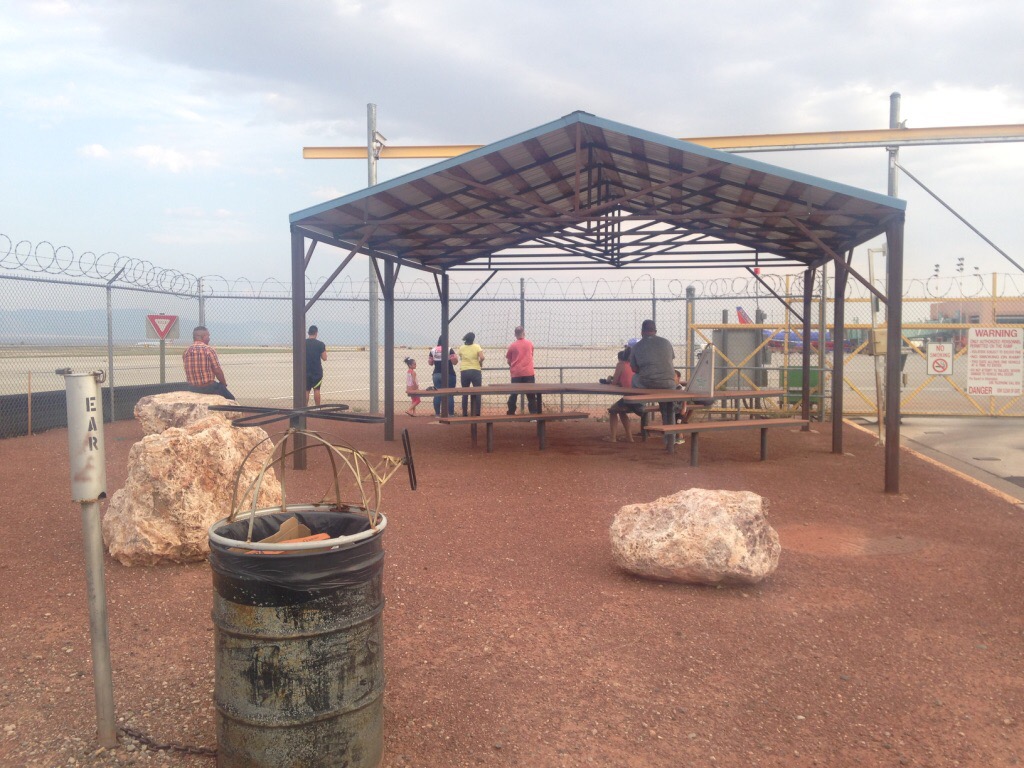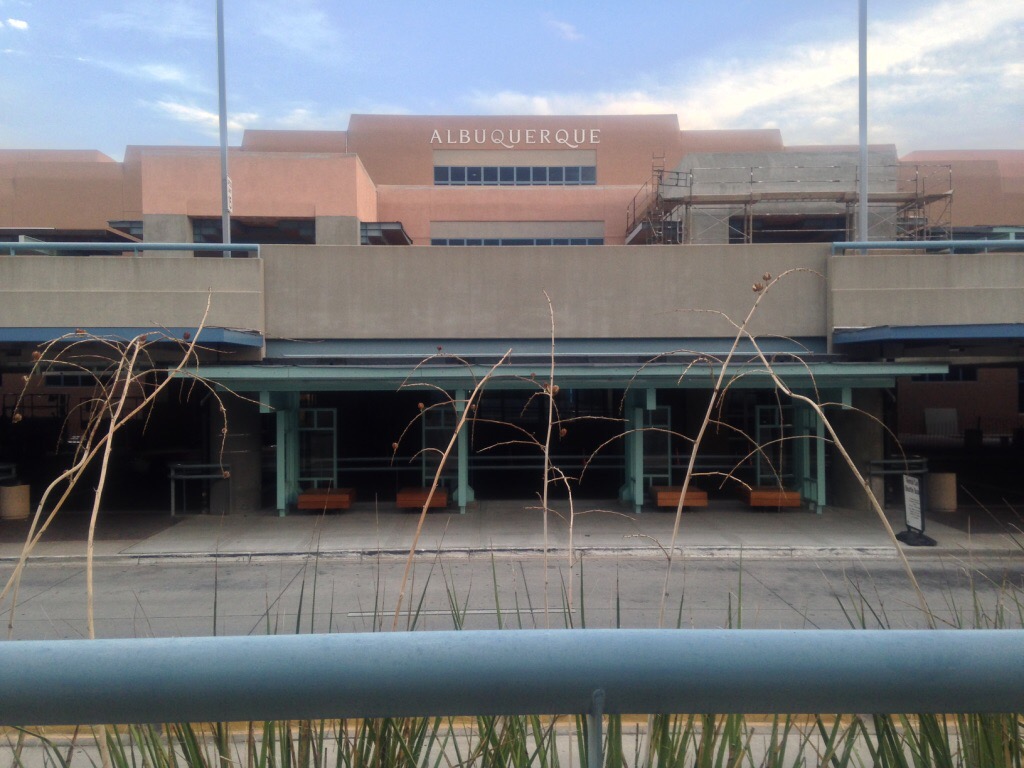The Albuquerque International Airport’s name changed in 1994, a trade of three letters, to Albuquerque International “Sunport.” Though it invokes the Zia Pueblo religious symbol at the center of the New Mexico flag, I’m not sure people who opted for the branding update anticipated it might also impart an intragalactic gravity. The name change was reportedly tried twice, but it’s fitting that it stuck in the 1990s, during a period of national economic expansion and as waves of white retirees began migrating south from cloudier, more prosperous parts of the country. Sunport makes me think of tech billionaires paying lots of money to be launched into a ball of hot plasma.
The airport sits on the city’s south side, on a plateau at the feet of the Sandia and Manzano Mountains and adjacent to the US military’s Kirtland Air Force Base. Only about 5 million travelers pass through annually; lines at the “security” checkpoint are rare. There are no iPad-outfitted dining rooms or high-end retailers. When passengers roll off the jetways, their wheeled baggage makes a racket against the lattice-patterned brick flooring.
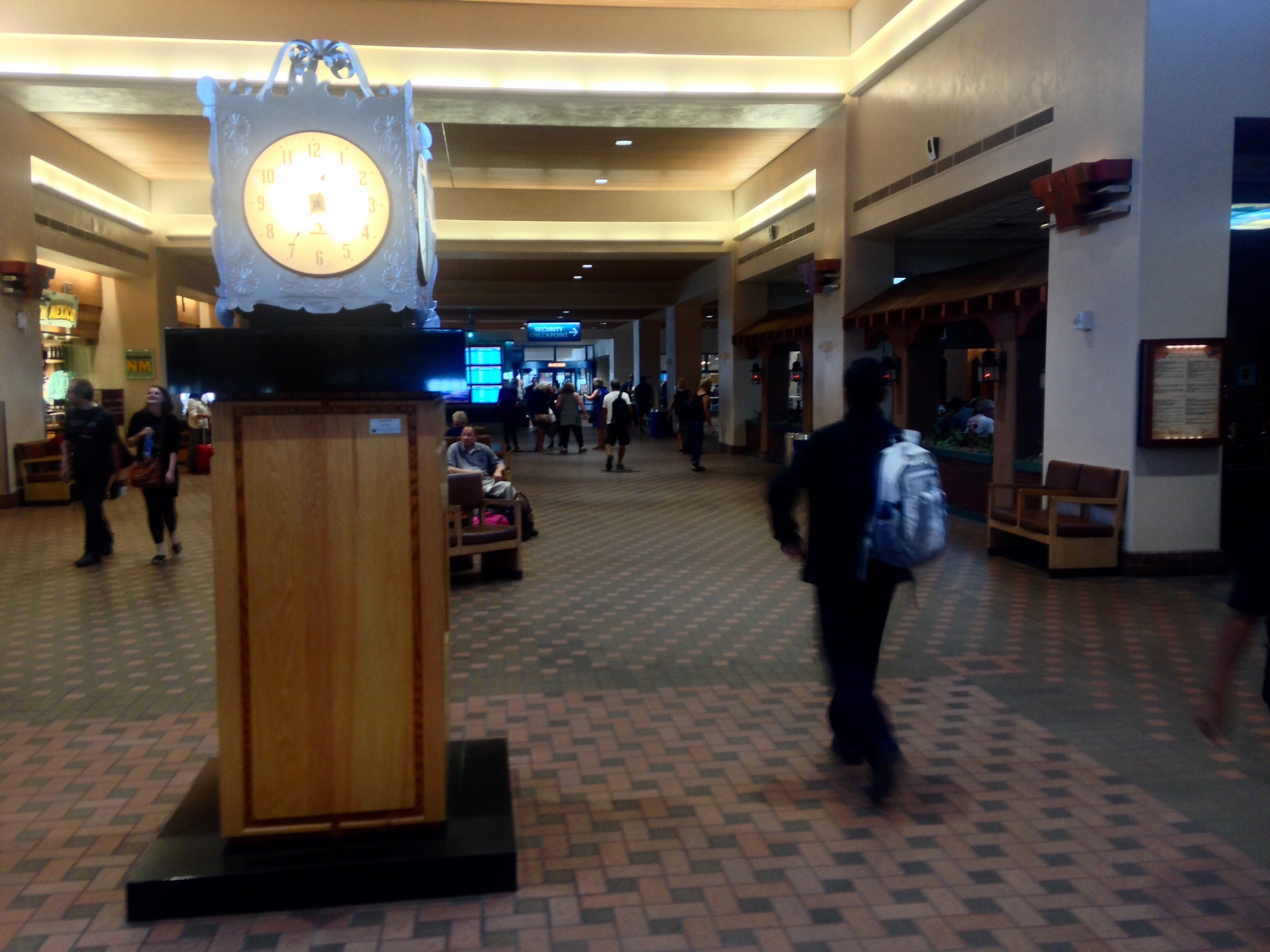
Though the airport’s brickwork is mass-produced, it’s an architectural reference to the way buildings here were historically built by hand, mud mixed with straw, molded and baked in the sun, grouted with more mud, arranged on packed sand. It’s details like these, forced mashups of old and new ways, that make the airport good preparation for this place.
You can draw a straight line, architecturally and ideologically, from the Sunport back to the city’s original airport terminal (1939–1965), and from there to Albuquerque’s first major tourist entryway, the Alvarado Hotel (1902–1970). Designers for the Alvarado Hotel were brought in during the turn of the last century by the Santa Fe Railroad and its hospitality partner, the Fred Harvey Company. The hotel drew heavily on California’s Spanish mission style: red tile roofing, glazed stucco, arcade walkways. The main attraction, though, was the hotel’s “Indian Building,” a late Gilded Age version of the museum gift shop. Interior designer Mary Colter drew from white missionary and ethnographic reports of Hopi tribal dwellings. When construction was complete, Native American artisans traveled many horse-drawn miles from their homelands to stage live demonstrations of traditional arts and crafts sold to the Alvarado’s gawking visitors.
Air travel and cars overtook the railroad’s primacy, and the Alvarado was demolished. But Ernest Blumenthal, the city architect who designed the original municipal airport terminal, no doubt took cues from what had compelled visitors to the Alvarado. His building, with high ceilings, hide-upholstered chairs, and exposed wooden vigas, alluded to many of the hotel’s ornamentations, especially its emphasis on traditional Native American arts and crafts.
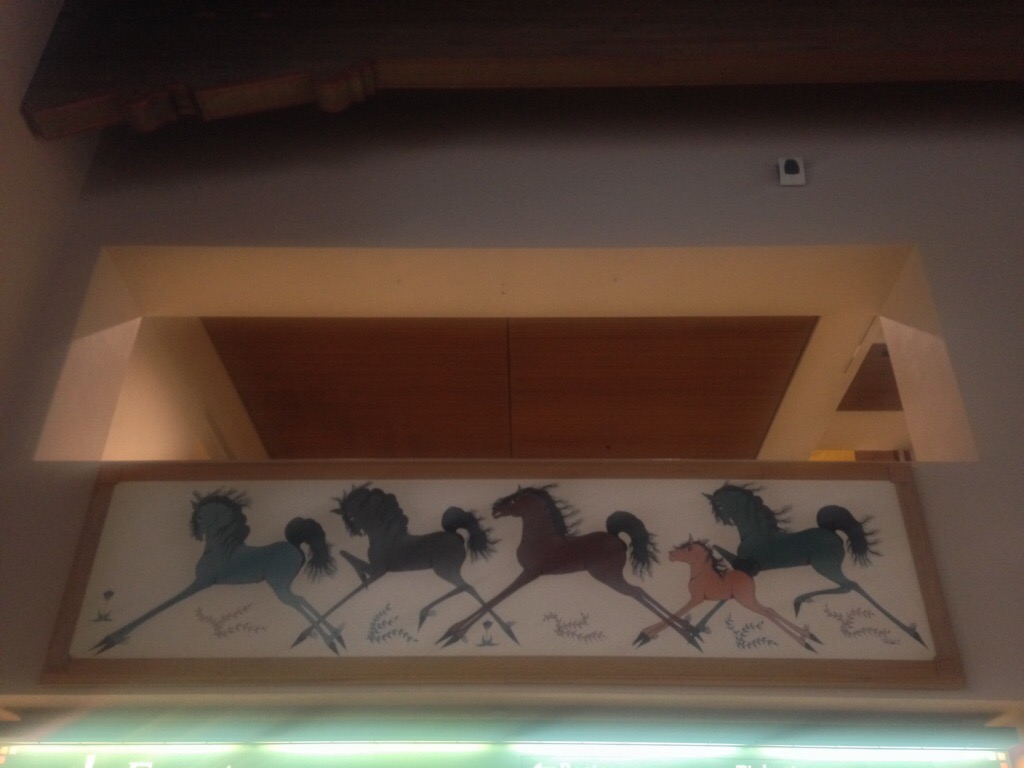
Blumenthal’s first terminal was constructed with New Deal Works Progress Administration funds and the talents and expertise cultivated over generations by Hispanic and Indigenous people. Today, the old airport is enclosed by a chain-link fence and houses the Transportation Security Administration, whatever that is, and the new Sunport is on the other side of that fence.
The Sunport’s three-level terminal is Pueblo Deco. The term was coined by a book of that name by architectural historian Marcus Whiffen and photographer Carla Breeze, who describe the form as Indigenous motifs “in a frankly modern architectural setting.” However degraded in material quality (or upgraded, depending on priorities; wooden beams, for one, were replaced by structural steel, sheathed with a false veneer), the Sunport’s remodel maintains welcoming, at times enthralling, placidity. There is nothing approximating the frantic pace, towering glass exposures, and interior grayscales of other airports, most of which turned their noses up at regional modernism years ago.
Pueblo Deco is aggressively showcased on the main exterior, a large-scale nod to traditionally terraced apartment houses made of adobe and designed for structural mass and airflow to conduct passive heating and cooling. The terrace form continues inside, with the lower level’s two wings converging below the terminal gates in a cavernous main hall. It mimics the interior of a Spanish colonial mission church constructed with wood, straw, mud, and forced labor. The center hall is an amplified, shiny version of their work, with soaring beams painted in bright Indigenous-derived motifs and end-capped with faux Pueblo Revival–style corbels. Instead of a Catholic altar at the centerpiece, there’s a suspended wooden biplane from 1914. It’s a lovely place to give thanks for human flight and/or confess a sinful attachment to jet fuel.
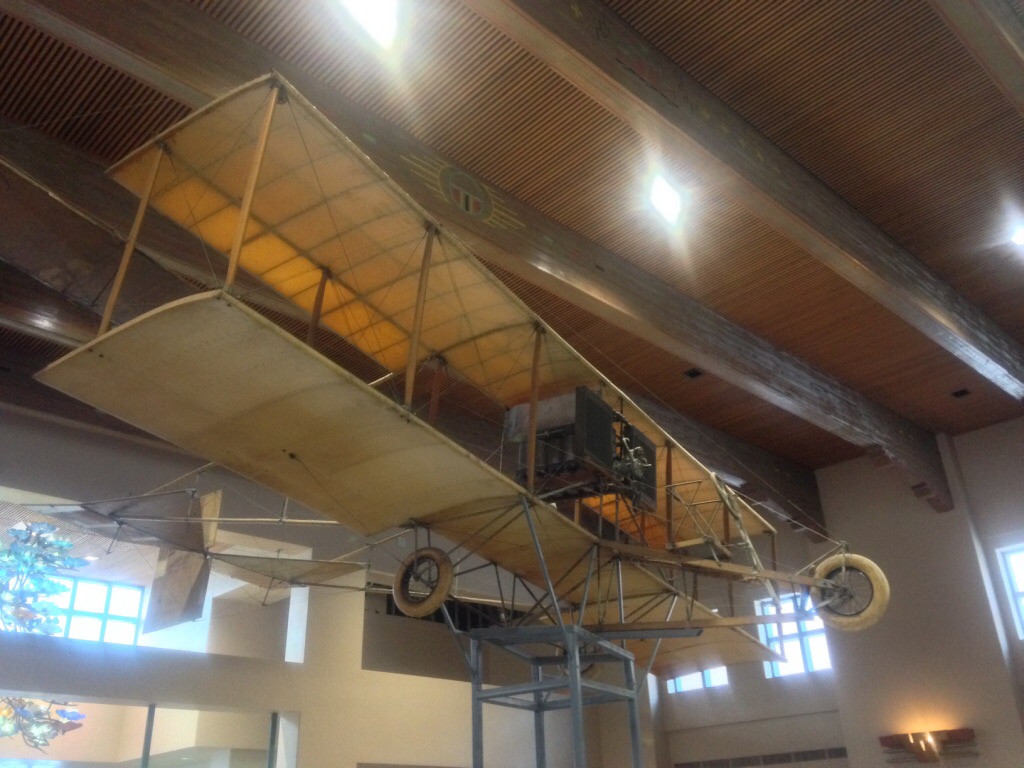
Museum-quality local art is also on display throughout the terminal. This makes sense: most visitors landing in Albuquerque are likely to head north right away, to Santa Fe and Taos. These towns’ edges are softer, more resort scented, compared to other places here; they’re New Mexico’s main draw for newcomers with money to spend. Their shared emphasis is on art and wilderness as immersive, tricultural marketplaces.
University of New Mexico anthropologist Marta Weigle’s studies of tourism led her to write in 1989 that marketers with the Santa Fe Railroad and Fred Harvey Company encouraged early visitors to regard the Southwest as a “secular pilgrimage center . . . a mythological holy land of grand natural wonders, inspirational primitive arts, and domesticated, artistic ‘natives.’ ” Contemporary messaging by the New Mexico Tourism Department (which sells #NMtrue swag at the Sunport) maintains that basic premise, if not the exact wording. According to the department’s website, anyone yearning for “Arts & Culture” will still be sated, even inspired, here. It’s a land where “Native American communities have sustained traditions that go back for thousands of years and Native American artists are know [sic] for their unique art forms both traditional and contemporary. [. . .] Opportunities exist to visit traditional communities and pueblos, and interact directly with the artists who reside there.”
Obviously there’s no mention in the tourism department’s inserts of how New Mexicans have developed their own survival skills in the face of colonialism and persistent poverty. Nor any mention of polluted air, soil, and water in New Mexico communities, much of it in the Albuquerque area, with direct ties to the airport’s adjacent military installation.
The US government designated the original WPA terminal Albuquerque Army Air Base in 1940, with a separate command center set up next door and renamed Kirtland Air Force Base two years later. The base still shares runways with the Sunport. In the words of the on-site Air Force Nuclear Weapons Center commander, Kirtland’s 51,558 acres comprise “the heart and soul of our [national] nuclear deterrent capacity,” a heart and soul that includes Sandia National Laboratories facilities. Like Los Alamos National Laboratories 98 miles northwest, Sandia Labs has been instrumental in the development and maintenance of the US nuclear-industrial complex.
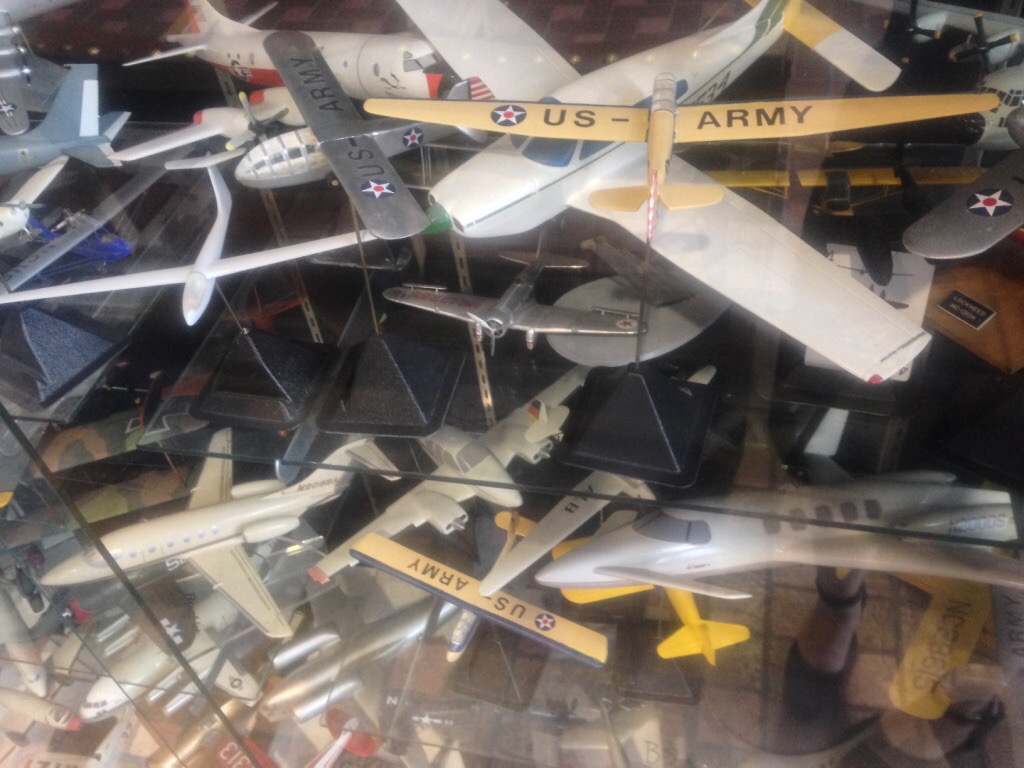
The city’s uptown-friendly paper of record, the Albuquerque Journal, has on at least one occasion acknowledged that “there have been controversies” stemming from the military’s work in the area. There was that time in 1957 when a bomber out of Biggs Air Force Base in El Paso accidentally dropped a 10-megaton hydrogen bomb just outside the city. Or that time in 1999 when someone noticed jet fuel had been seeping for decades out of Kirtland and into our groundwater. Our state government recently discovered that the Department of Energy and Sandia National Labs had a habit of dumping hazardous waste in unpermitted landfills and releasing industrial wastewater into septic systems and the local watershed.
A friend who lives back East told me last summer after driving (not flying) through northern New Mexico for the first time that they’d felt “unbalanced by the lack of civilization.” The less idealized view from the Sunport indicates it’s the “civilized” Western world that has so set things into imbalance that the Southwest verges on inhospitable. New climate models indicate we may endure more intense megadroughts than ever before in our climate record. The last time this area fell under such conditions was nearly a thousand years ago. They may have triggered abandonment of the advanced population centers constructed by ancestors of Indigenous people living here today.
Much of the work by locals—whose ancestors built this place—isn’t highlighted by our tourism infrastructure, airport included. Native New Mexicans are among the Indigenous people counteracting the pollution of more-potent economic drivers. They conduct direct protective measures for local water supplies. They build coalitions to preserve Native American tribal sovereignty, habitable air and water. Contributions like these don’t match the tourism industry gloss on culture as a thing easily acquired for individual illumination and ornamentation. Newcomers are invited to absorb the raw beauty of this place from a soothing distance.
Growing up here, the Sunport was central to my escapism. I daydreamed about packing light, lifting off to cities with shaded bus stops and green horizons. My family has been here for three generations, and there are palpable aftereffects of living somewhere treated as a container to be used and discarded according to the needs of those in power. That’s despite my white protective coatings. These days, people with means tend to pack up their kids and depart.
Yet any long stints of distance I’ve managed inspire homesickness more clinical than mere longing, an attachment so umbilical it is beyond remedy. The desire to stay, deplaned and shouldering a quiet carry-on, jumpstarting the bleached-out car, coming home to the swamp cooler busted, silt blown in under the door, is as strong as gravity. It’s a stubborn insistence to dig in that declares daily victory over the yearning to fly away.
